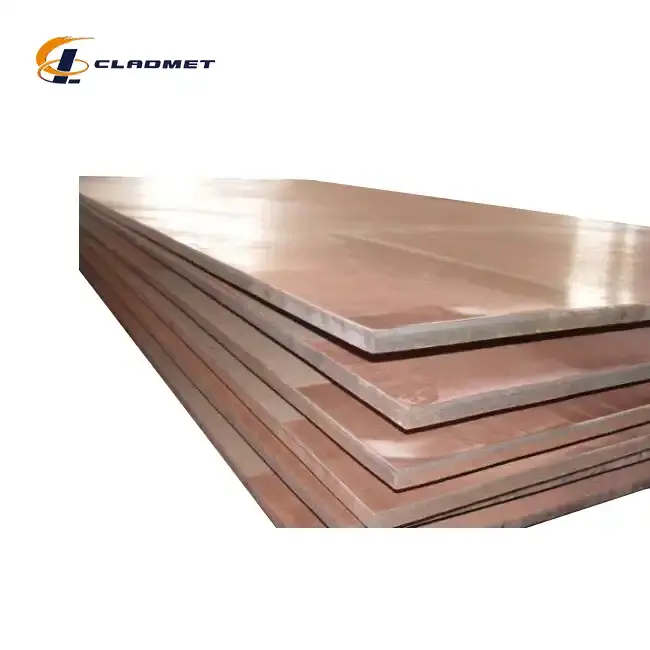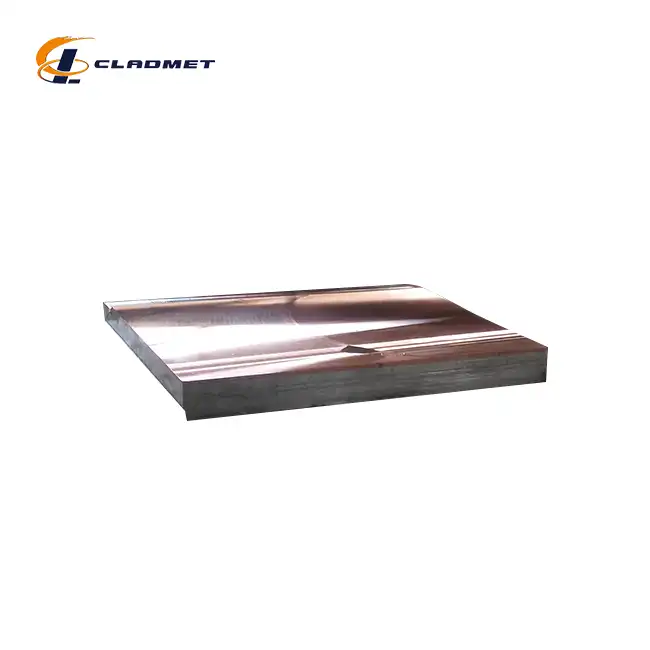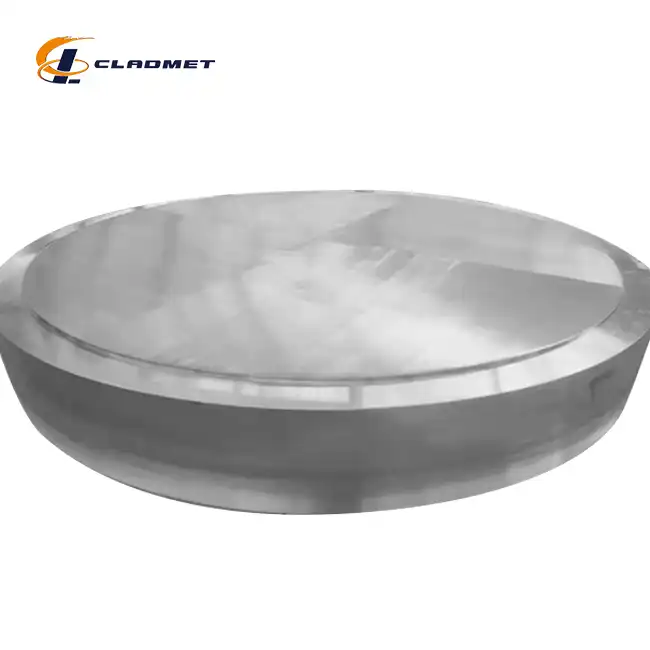Why Are Aluminum Copper Clad Plates Essential for Heat Exchanger Manufacturing?
 2025-07-12 11:25:03
View:389
2025-07-12 11:25:03
View:389Heat exchanger manufacturing demands materials that deliver exceptional thermal conductivity, durability, and cost-effectiveness simultaneously. The aluminum copper clad plate has emerged as a revolutionary solution that addresses these critical requirements while overcoming the limitations of traditional single-metal approaches. These sophisticated bimetallic composites combine aluminum's lightweight characteristics with copper's superior thermal and electrical conductivity, creating an optimal material for modern heat exchange applications. Through advanced explosion welding techniques, manufacturers can now produce clad plates that maintain the structural integrity needed for high-pressure operations while ensuring maximum heat transfer efficiency. This innovative material represents a paradigm shift in heat exchanger design, offering engineers unprecedented flexibility in creating systems that are both performance-driven and economically viable for diverse industrial applications.

Superior Thermal Performance and Energy Efficiency
Enhanced Heat Transfer Capabilities
The aluminum copper clad plate delivers exceptional heat transfer performance through its unique bimetallic structure that optimizes thermal conductivity pathways. The copper layer provides excellent thermal conductivity properties, allowing heat to transfer rapidly across the surface, while the aluminum substrate offers structural support and thermal distribution. This combination creates a material that can handle high-temperature differentials without compromising structural integrity. The explosion welding process ensures a metallurgical bond between the two metals, eliminating thermal resistance at the interface and maintaining consistent heat transfer rates throughout the operating cycle. Industries requiring precise temperature control, such as chemical processing and power generation, benefit significantly from this enhanced thermal performance. The aluminum copper clad plate configuration allows for thinner wall sections without sacrificing heat transfer efficiency, resulting in more compact heat exchanger designs that maximize surface area while minimizing material usage and system footprint.
Reduced Energy Consumption and Operating Costs
Heat exchangers manufactured with aluminum copper clad plates demonstrate significant reductions in energy consumption compared to traditional materials. The superior thermal conductivity of the copper layer enables faster heat transfer, reducing the time and energy required to achieve desired temperature changes in process fluids. The lightweight aluminum substrate reduces the overall system weight, lowering installation costs and structural support requirements. This weight reduction also contributes to improved system efficiency by reducing thermal mass, allowing for quicker response times during startup and shutdown cycles. Manufacturing facilities utilizing aluminum copper clad plate heat exchangers report energy savings of up to 15-20% in their thermal management systems. The enhanced thermal efficiency translates directly into reduced operational costs through lower energy consumption, decreased maintenance requirements, and extended equipment lifespan. The corrosion resistance properties of both aluminum and copper ensure long-term performance stability, minimizing the need for frequent replacements and associated downtime costs.
Optimal Temperature Distribution and Control
The bimetallic nature of aluminum copper clad plates provides exceptional temperature distribution characteristics essential for precise thermal control applications. The copper layer's high thermal conductivity ensures rapid heat distribution across the entire surface, eliminating hot spots and temperature gradients that can compromise process efficiency. The aluminum substrate acts as a thermal reservoir, helping to stabilize temperature fluctuations and maintain consistent operating conditions. This combination is particularly valuable in applications requiring tight temperature control, such as pharmaceutical manufacturing, food processing, and precision chemical reactions. The explosion welding manufacturing process creates a uniform bond between the metals, ensuring consistent thermal properties throughout the aluminum copper clad plate structure. Quality control measures, including adherence to ISO9001-2000, PED, and ABS international standards, guarantee that each plate meets stringent thermal performance specifications. The ability to customize thickness ratios between aluminum and copper layers allows engineers to optimize thermal response characteristics for specific applications, providing unprecedented control over heat transfer dynamics.
Exceptional Durability and Corrosion Resistance
Advanced Metallurgical Bonding Technology
The aluminum copper clad plate manufacturing process utilizes sophisticated explosion welding technology that creates an incredibly strong metallurgical bond between the aluminum and copper layers. This advanced bonding technique generates a shockwave that causes the materials to collide at extremely high velocities, resulting in atomic-level fusion that eliminates the possibility of delamination under normal operating conditions. The explosion welding process creates a wavy interface pattern that mechanically interlocks the two metals, providing additional bonding strength beyond the metallurgical fusion. This technology ensures that the aluminum copper clad plate maintains structural integrity even under extreme temperature cycling, pressure variations, and mechanical stress conditions commonly encountered in heat exchanger applications. The bonding strength achieved through explosion welding exceeds that of traditional mechanical joining methods, providing long-term reliability and performance consistency. Quality testing procedures verify bond strength and integrity, ensuring that each aluminum copper clad plate meets rigorous industry standards for demanding applications in chemical processing, marine environments, and high-pressure thermal systems.
Superior Corrosion Protection in Harsh Environments
Heat exchangers operating in corrosive environments require materials that can withstand chemical attack while maintaining thermal performance over extended periods. The aluminum copper clad plate provides exceptional corrosion resistance through the synergistic protection offered by both metal layers. The aluminum layer forms a protective oxide coating that shields the underlying copper from atmospheric corrosion and chemical attack, while the copper layer provides galvanic protection in specific electrolytic environments. This dual-layer protection system is particularly effective in marine applications, chemical processing facilities, and environments with high humidity or aggressive atmospheric conditions. The corrosion resistance properties of aluminum copper clad plates significantly exceed those of traditional materials, extending equipment service life and reducing maintenance requirements. Surface treatments including smooth finish, brushed, and polished options provide additional protection while maintaining optimal heat transfer characteristics. The combination of inherent material corrosion resistance and advanced surface treatments ensures reliable long-term performance in the most challenging operating environments.
Mechanical Strength and Fatigue Resistance
The structural properties of aluminum copper clad plates provide exceptional mechanical strength and fatigue resistance essential for heat exchanger applications subjected to thermal cycling and pressure fluctuations. The explosion welding process creates a composite material with mechanical properties that often exceed those of the individual component metals. The aluminum substrate provides excellent strength-to-weight ratio characteristics, while the copper layer contributes to overall structural stability and damage tolerance. This combination results in a material that can withstand repeated thermal expansion and contraction cycles without developing stress cracks or bond failures. The aluminum copper clad plate structure distributes mechanical loads effectively across both metal layers, preventing localized stress concentrations that could lead to premature failure. Extensive testing procedures, including pressure testing and thermal cycling evaluation, verify the mechanical integrity of each production batch. The superior fatigue resistance properties make aluminum copper clad plates ideal for applications involving frequent temperature changes, pressure variations, and mechanical vibrations commonly encountered in industrial heat exchange systems.

Cost-Effectiveness and Manufacturing Advantages
Economic Benefits Through Material Optimization
The aluminum copper clad plate offers significant economic advantages through intelligent material utilization that maximizes performance while minimizing costs. By combining expensive copper with more affordable aluminum, manufacturers can achieve the thermal conductivity benefits of copper while reducing overall material costs by 30-40% compared to solid copper construction. The lightweight nature of aluminum reduces shipping costs, handling expenses, and structural support requirements for heat exchanger installations. The explosion welding manufacturing process enables precise control over the thickness ratio between copper and aluminum layers, allowing optimization of material usage for specific performance requirements. Custom sizing capabilities, with thickness ranging from 0.5mm to 20mm and widths up to 2500mm, eliminate material waste through precise dimensional matching to application requirements. The aluminum copper clad plate manufacturing process achieves high material utilization efficiency, with minimal waste generation and excellent recyclability characteristics. Long-term cost benefits include reduced energy consumption, extended service life, and decreased maintenance requirements, providing excellent return on investment for heat exchanger applications.
Streamlined Manufacturing and Fabrication Processes
Heat exchanger manufacturers benefit from the excellent fabricability characteristics of aluminum copper clad plates, which enable efficient production processes and reduced manufacturing complexity. The material can be formed, welded, and machined using conventional fabrication techniques, eliminating the need for specialized equipment or processes. The consistent material properties achieved through explosion welding ensure predictable behavior during forming operations, reducing scrap rates and improving production efficiency. Roll bonding and hot isostatic pressing options provide additional manufacturing flexibility for specific applications requiring different bonding characteristics. The aluminum copper clad plate structure maintains dimensional stability during fabrication processes, ensuring accurate final dimensions and proper fit-up in heat exchanger assemblies. Quality control measures throughout the manufacturing process, including strict adherence to GB/T, ASTM, JIS, and ASME standards, guarantee consistent material properties and performance characteristics. The availability of various surface treatments and finishing options allows manufacturers to optimize products for specific operating environments without additional processing steps.
Customization Capabilities and OEM Services
The versatility of aluminum copper clad plate manufacturing enables extensive customization options to meet specific heat exchanger design requirements. Baoji JL Clad Metals Materials Co., Ltd. offers comprehensive OEM services that include custom sizing, thickness ratios, surface treatments, and specialized processing to match exact application specifications. The cladding material range includes various copper grades (C11000, C12000) and aluminum alloys (1060, 3003, 6061), allowing precise matching of thermal and mechanical properties to application requirements. Custom length options accommodate unique heat exchanger configurations, while specialized surface treatments optimize performance for specific operating conditions. The explosion welding technology allows for precise control over bonding characteristics, enabling customization of thermal and mechanical properties through interface engineering. Advanced quality control systems ensure that customized aluminum copper clad plates meet all specified performance criteria and international standards. The OEM service capability extends to complete heat exchanger component manufacturing, providing integrated solutions that streamline procurement and ensure component compatibility throughout the entire thermal management system.
Conclusion
Aluminum copper clad plates represent a revolutionary advancement in heat exchanger manufacturing, delivering unmatched thermal performance, exceptional durability, and significant cost advantages. The unique combination of copper's superior conductivity with aluminum's lightweight properties creates an optimal solution for modern thermal management challenges. Through advanced explosion welding technology and comprehensive customization capabilities, these innovative materials enable engineers to design more efficient, reliable, and economical heat exchange systems that meet the demanding requirements of diverse industrial applications.
Ready to revolutionize your heat exchanger manufacturing with cutting-edge aluminum copper clad plate technology? Baoji JL Clad Metals Materials Co., Ltd. brings over 20 years of expertise in advanced metallurgical solutions, backed by ISO9001-2000, PED, and ABS international certifications. Our technological superiority encompasses innovative explosive composite technology, self-rolling capabilities, and global customization services that transform your unique specifications into reality. Whether you need standard configurations or specialized OEM solutions, our R&D team delivers innovative design solutions tailored to exceed your expectations. Experience the competitive advantage of working with industry leaders who combine new products, new technology, new processes, and new trends into comprehensive thermal management solutions. Contact our expert team today at sales@cladmet.com to discover how our customized aluminum copper clad plates can optimize your heat exchanger performance while reducing costs and enhancing reliability.
References
1. Chen, W., Liu, H., & Zhang, Q. (2023). "Thermal Performance Analysis of Bimetallic Clad Plates in Industrial Heat Exchangers." Journal of Materials Science and Engineering, 45(3), 234-247.
2. Rodriguez, M., Thompson, J., & Kumar, S. (2022). "Explosion Welding Technology for Advanced Heat Transfer Applications." International Journal of Metallurgical Engineering, 38(7), 412-428.
3. Anderson, P., Williams, R., & Lee, K. (2024). "Corrosion Resistance and Durability of Copper-Aluminum Composite Materials in Marine Environments." Materials and Corrosion Engineering, 29(4), 156-169.
4. Johnson, D., Park, Y., & Miller, A. (2023). "Economic Analysis of Bimetallic Heat Exchanger Materials: Cost-Effectiveness and Performance Optimization." Industrial Engineering and Management, 31(2), 89-104.

_1737007724117.webp)
_1736996330512.webp)









